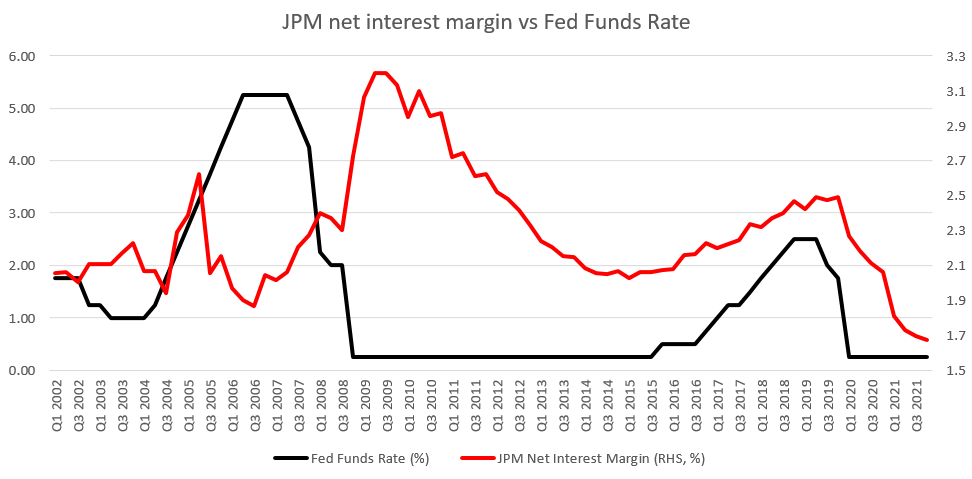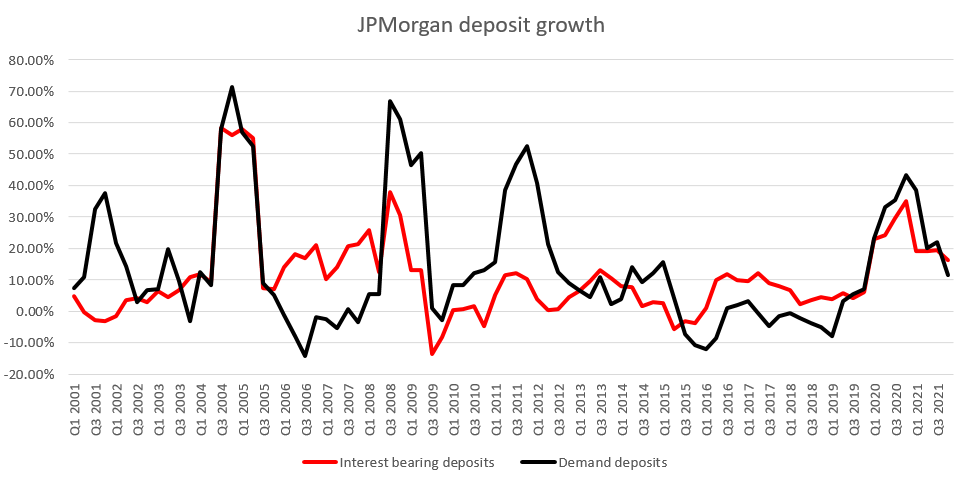-
Fed became more hawkish
-
At least 6 more rate hikes expected this year
-
QT may begin in May
-
Impact on commercial banks uncertain in short-term
-
JP Morgan stock rallied after FOMC decision
The Federal Reserve was quite hawkish yesterday. A rate hike was delivered and dot-plot was adjusted to market expectations. On top of that, a strong hint was made that a decision to begin reduction of the balance sheet will come during the next meeting in May. While the Fed has a big impact on the whole US economy, this impact is even larger when it comes to the US financial sector. Let's take a look at what the upcoming Fed's policy move may mean for big US banks like for example JPMorgan, the biggest US bank.
Interest rates will rise quickly
إبدأ بالإستثمار اليوم أو تدرّب على حساب تجريبي
إنشاء حساب حساب تجريبي تحميل تطبيق الجوال تحميل تطبيق الجوالNew dot-plot showed that the median expectation among US central bankers is for at least 6 more rate hikes this year, meaning that a 25 basis point rate hike would have to come at almost every meeting. An increase in interest rates is generally seen as favorable for commercial banks as higher nominal level of interest rates makes it easier for banks to expand their net interest margin. From this point of view, much more hawkish Fed expectations are beneficial for banks like JP Morgan. However, it turns out that this improvement in business is not instantaneous. As is presented on the chart below, there is a significant lag between changes in Fed Funds Rate and changes in JP Morgan's net interest income. Having said that, it may take a few quarters until the full impact of the current rate hike cycle is reflected in earnings.
 Changes in JP Morgan's net interest margin lagged changes in Fed Funds Rate quite significantly in the past. Source: Bloomberg, XTB
Changes in JP Morgan's net interest margin lagged changes in Fed Funds Rate quite significantly in the past. Source: Bloomberg, XTB
QT impact: slower deposit growth?
Another big takeaway from yesterday's FOMC meeting is that reduction of Fed's balance sheet, or quantitative tightening (QT), may begin as soon as in May. QE is boosting liquidity in the financial system and therefore have a positive impact on deposit growth. As QT is opposite to QE, one could assume that a reverse situation would take place. Indeed, analyst desks at major financial institutions expect deposit growth to slow once the Fed starts to remove liquidity from the system. Nevertheless, this slowdown is not expected to be major and growth is not expected to turn negative. Year-over-year growth in JPMorgan deposits was presented on the chart below. Blue circle marks the period of the first QT done by the Fed (Q4 2017 - Q3 2019). As one can see, changes in growth rates were not big. Growth of demand deposits, that account for 20-30% of total customer deposits, was negative. However, it was negative even before QT started. Growth in interest bearing deposits was barely changed.
 JPMorgan experienced a drop in demand deposits during the first Fed QT (blue circle) but growth in interest bearing deposits was barely changed. Source: Bloomberg, XTB
JPMorgan experienced a drop in demand deposits during the first Fed QT (blue circle) but growth in interest bearing deposits was barely changed. Source: Bloomberg, XTB
Economy is slowing
As was presented above, impact of more hawkish Fed policy is not specifically positive or negative for commercial banks, especially not in the short-term. In the longer term, effects of higher interest rates are likely to result in a positive net effect on operations. Nevertheless, QT could hamper growth in deposits, which would be negative for scale of the business, and therefore future benefits of higher net interest margin.
One important thing to consider is that banks are cyclical stocks that are highly correlated with the economy. It is not a secret that the global economy is slowing after a post-pandemic recovery and the Russia-Ukraine war has made this only more evident. As such, benefits of more hawkish Fed policy may not have as big and imminent effect on share price as to offset expectations of an impending period of weaker growth or maybe even recession. As JP Morgan is the biggest US bank in terms of assets, the impact of economic slowdown or recession is expected to be clearly visible in its earnings.
 A look at JP Morgan (JPM.US) chart shows that stock reacted very positively to yesterday's hawkish FOMC decision. Share price jumped over 3.5% yesterday. The near-term resistance zone to watch can be found in the $141.50 area. Key support to watch is located in the $147.00 area and marked with the upper limit of the Overbalance structure. Source: xStation5
A look at JP Morgan (JPM.US) chart shows that stock reacted very positively to yesterday's hawkish FOMC decision. Share price jumped over 3.5% yesterday. The near-term resistance zone to watch can be found in the $141.50 area. Key support to watch is located in the $147.00 area and marked with the upper limit of the Overbalance structure. Source: xStation5
